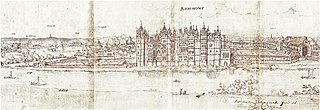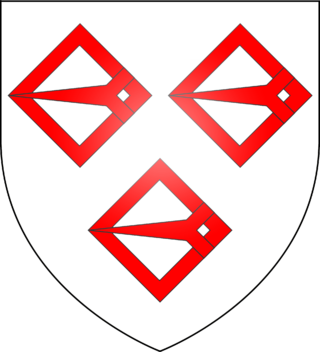
Costessey Hall (pronounced and sometimes spelt Cossey Hall, also written as Cotesby Hall) was a manor house in Costessey, Norfolk, England, four miles west of Norwich.

Costessey Hall (pronounced and sometimes spelt Cossey Hall, also written as Cotesby Hall) was a manor house in Costessey, Norfolk, England, four miles west of Norwich.
The first mention of the hall dates it to circa 1086, when William the Conqueror gave it to Alan Rufus, Earl of Richmond. It was then described as Costessey Manor. [1]
In 1555, Mary I awarded it to Sir Henry Jerningham, for his support for Mary on the contested accession of Lady Jane Grey. It then had 22 sub-manors in Norfolk, plus manors in Hereford and Gloucestershire. Jerningham built a new manor house on the south side of the River Tud flowing through Costessey. The original manor house remained on the north side of the river and is still standing in Costessey Park. It may have been granted to Anne of Cleves by her husband Henry VIII. [2]
From 1826 to 1836, John Chessell Buckler built a Gothic castle for Lord Stafford Jerningham, which was several times larger than the original Tudor hall. [2]
In 1913, the contents of the house were sold, and the hall was left empty. At the start of World War I, it was commandeered by the War Office. In 1919, it was decided to demolish the hall. The house was demolished in 1925. The belfry block by the 18th fairway of the Costessey Park Golf Course is all that remains. [2]

The River Wensum is a chalk river in Norfolk, England and a tributary of the River Yare, despite being the larger of the two rivers. The river is a biological Site of Special Scientific Interest and Special Area of Conservation.

Baron Stafford, referring to the town of Stafford, is a title that has been created several times in the Peerage of England. In the 14th century, the barons of the first creation were made earls. Those of the fifth creation, in the 17th century, became first viscounts and then earls. Since 1913, the title has been held by the Fitzherbert family.

Costessey is a town and civil parish in the South Norfolk district of Norfolk, England, and is 4 miles (6.4 km) north west of Norwich. The civil parish forms part of the Norwich Urban Area.

Richmond Palace was a Tudor royal residence on the River Thames in England which stood in the sixteenth and seventeenth centuries. Situated in what was then rural Surrey, it lay upstream and on the opposite bank from the Palace of Westminster, which was located nine miles (14 km) to the north-east. It was erected in about 1501 by Henry VII of England, formerly known as the Earl of Richmond, in honour of which the manor of Sheen had recently been renamed "Richmond". Richmond Palace therefore replaced Shene Palace, the latter palace being itself built on the site of an earlier manor house which had been appropriated by Edward I in 1299 and which was subsequently used by his next three direct descendants before it fell into disrepair.

Barton Bendish is a civil parish and small ancient village in the English county of Norfolk located 10 miles (16 km) south of King's Lynn and 90 miles (140 km) north-east of London. It has two medieval parish churches, and once had three. The parish includes the old hamlet of Eastmoor, and covers 3,936 acres (1,593 ha). The village has been settled since Neolithic times and was expanded during the Saxon period. Today the village has a population of 210 as recorded at the 2010 census and contains eight listed buildings, with the two medieval parishes churches being Grade I.

The Jerningham Baronetcy, of Cossey in the County of Norfolk, was a title in the Baronetage of England. It was created on 16 August 1621 for Henry Jerningham. The 5th Baronet married Mary Plowden, only daughter of Mary Plowden, sister of John Paul Stafford-Howard, 4th Earl of Stafford and de jure 5th Baron Stafford. He was succeeded by his son, the sixth Baron. In 1807 the claim to the barony of Stafford, which had been under attainder since 1680, passed to him through his mother. He died in 1809 when the baronetcy and the claim to the barony passed to his son, the seventh Baronet. He petitioned the House of Lords for a reversal of the attainder of the barony of Stafford and for a writ of summons to Parliament. In 1824 the attainder was reversed and the following year he was summoned to the House of Lords as the eighth Baron Stafford.

Swynnerton Hall is an 18th-century country mansion house, the home of Lord Stafford, situated at Swynnerton near Stone, Staffordshire. It is a Grade I listed building.
Mary Scrope was an English courtier. She was the granddaughter of Henry Scrope, 4th Baron Scrope of Bolton, and the sister of Elizabeth Scrope, wife of John de Vere, 13th Earl of Oxford, and Margaret Scrope, wife of Edmund de la Pole, 3rd Duke of Suffolk. She is said to have been in the service at court of King Henry VIII's first four wives. As the wife of Sir William Kingston, Constable of the Tower of London, she was in attendance on Anne Boleyn during the Queen's brief imprisonment in the Tower in May 1536, and both she and her husband were among those who walked with the Queen to the scaffold. By her first husband, Edward Jerningham, she was the mother of Sir Henry Jerningham, whose support helped to place Queen Mary I on the throne of England in 1553, and who became one of Queen Mary's most favoured courtiers.
Sir Henry Jerningham KB was an English courtier during the Tudor period. He was a Gentleman Pensioner during the reign of Henry VIII. In the succession crisis of 1553 he was one of the foremost supporters of Mary Tudor, and after her accession was one of her most trusted servants, being appointed Vice-Chamberlain of the Household, Captain of the Yeomen of the Guard, and a member of the Privy Council.

Henry Valentine Stafford-Jerningham, 9th Baron Stafford DL, known as Henry Jerningham until 1824 and styled The Honourable Henry Stafford-Jerningham between 1824 and 1851, was a British peer and politician.
Sir John Sulyard, of Wetherden and Haughley, Suffolk, was a prominent East Anglian magistrate, landowner, High Sheriff, knight and standard-bearer, strongly Roman Catholic in religious affiliation, who sat in parliament during the reign of Queen Mary.

Hoveton Hall in the parish of Hoveton in Norfolk is a Regency-style country house made of gault brick with a slate roof. It was built between 1809 and 1812, on or near the site of the previous ancient manor house of the same name, by Mrs Christabell Burroughes (1764-1843), daughter and heiress of Henry Negus (1734-1807) of Hoveton Hall, an attorney, and wife of James Burkin Burroughes (1760-1803) of Burlingham Hall, Norfolk. The architect was Humphry Repton. It is a well-preserved historic house of significance on the English Heritage Register. The Negus family had been seated at Hoveton Hall for several generations. The surrounding estate today consists of 120 acres of gardens and parkland and 450 acres of arable land as well as picturesque woodland. The gardens are open to the public during part of the year and there are facilities available for accommodation and special events including weddings.

Haughley Park House in Stowmarket, Suffolk is an historical house of significance listed in the English Heritage Register. It is a large red brick country house built in about 1620 for the Sulyard family who were very prominent landowners in this area. The property remained with this family for two centuries after which it was sold. Today it is a private residence but at certain times of the year the gardens are open for viewing. The barn and gardens are also available for weddings.
George William Stafford-Jerningham, 8th Baron Stafford, known as Sir George William Jerningham, 7th Baronet from 1809 to 1824, was a British peer who, in 1824, successfully obtained a reversal of the attainder of the barony of Stafford.
Hon. Sir George Sulyarde Stafford-Jerningham KCH CB, was an English career diplomat who served as the British Minister to Sweden from 1859 to 1872.
Hon. William George Stafford-Jerningham was an English career diplomat.
Hon. Edward Robert Petre of Stapleton Park was an English horse racer and politician.

Sir William Jerningham, 6th Baronet, de jure 7th Baron Stafford was an English landowner.
Sir Henry Richard Paston-Bedingfeld, 6th Baronet JP DL, was an English landowner and baronet.